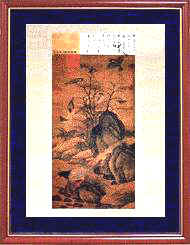
Huang Chu-tsˇ¦ai (933-after 993), Sung Dynasty
Original: Hanging scroll, ink and colors on silk, 97 x 53.6 cm
 |
 |
 |
 |
ˇ@
Huang Chu-tsˇ¦ai, a native of Szechwan province, was the son of the famous bird-and-flower painter Huang Chˇ¦uan. He followed in his fatherˇ¦s style of outlining forms with thin brushstrokes and then filling them with colors. The paintings by the two Huangs set the standard for artistic excellence in the painting academy of the early Sung dynasty (960-1279).
This work is an excellent example of the balance between action and stillness. Take, for example, the blue magpie in the lower section of the scroll. It appears to have just jumped onto the rock as it bends down to take a drink from the stream below. Despite the stillness, it suggests both the previous and future movement. The forms actually in movement, however, are the sparrows above, which are fly, chirp, or gaze about. The slender bamboo, phoenix-tail bracken, and clumps of grass in the foreground extend horizontally in both directions for balance and peace. Therefore, this painting imparts a sense of ease and calm.
The magnificent blue magpie extends almost from one edge of the painting to the other, with the rest of the scene filled with a large rock and slope, thorny shrubs, bamboo, grass, and sparrows arranged along a vertical axis. The weight of the composition is located in the middle of the painting, correlating to a similar practice in Northern Sung landscape painting. The patternistic effect of the arrangement is also decorative, which reflects the artistˇ¦s awareness of the archaic and beautiful style of bird-and-flower painting practiced in the Tˇ¦ang dynasty (618-907).
